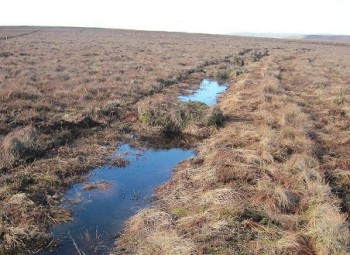Supporting guidance for Ditch Blocking – Peat Dams
Date published: 5 February, 2016
To see recent changes to this guidance, check the bottom of this page.
Choice of dam – peat dams or plastic piling?
Peat dams should be considered the default technique to block ditches or moor grips. They are much cheaper to install than dams made of other materials, especially where a large number of dams are required. Peat dams work well on shallow peat where plastic dams cannot form a watertight seal.
Peat dams are only successfully in peat with a shallow slope. Peat dams cannot include an overflow and are made of soft material. If the gradient is too steep the water flow can cause erosion over the top of the dam resulting in failure. Where dams need to be installed on the sloping edges of bogs, we recommend you use plastic piling.
You can build peat dams by hand in ditches of up to 70 centimetres wide and 60 centimetres deep. Machine-built dams can be in ditches up to 150 centimetres wide and 120 centimetres deep, depending on the peat composition. Above these dimensions, the peat dam structure can become unstable particularly if flow rates are high.
Siting of dams
Careful planning is required to correctly locate active ditches, estimate the correct number of dams required and where these should be placed in order to effectively block a ditch. Certain locations, such as dry peat banks should be avoided.
Generally dams are placed at 20 to 30 metre intervals. The precise intensity of damming depends on the flow of water in the ditch, the slope and the amount of water held back by each dam. Aim for the final water level to be at the surface or no more than 20 centimetres below the peat surface. The distance between dams should be such that there is one dam per 25 centimetres drop in ground level.
Methods
Peat dams can be constructed by hand or machine digging. Careful planning is more important for machine digging as access to bogs and availability of machinery can be limiting. You should state which method you propose to use in your Ditch Blocking Plan.
Each individual peat dam must be installed to the full depth and width of the grip, in accordance with the dam construction requirements below.
If, during year four, more than 10 per cent of the dams are not holding water, you must repair or replace them (adjacent to existing dam).
Producing a plan
When submitting your application you should include a Ditch Blocking Plan. You should state in your plan what methods you are using and you should state why these have been selected. Include details of the number and locations of the ditches and dams.
If you are producing another management plan, for example a Moorland Management Plan, it may be appropriate to include details of your ditch blocking work as a sub-section of this plan.

Ditch blocking with peat dams – Credit: Andrew McBride, Scottish Natural Heritage
Related management options
Related capital items
Futher information
Detailed information on how to install peat dams is available from the Peatland Action page of the Scottish Natural Heritage website.
Recent changes
| Section | Change | Previous text | New text |
|---|---|---|---|
| Choice of dam – peat dams or plastic piling? | Clarification of guidance. | Machine-built dams can be up to 150 centimetres wide and 120 centimetres deep, depending on the peat composition. | Machine-built dams can be in ditches up to 150 centimetres wide and 120 centimetres deep, depending on the peat composition. |
Previous versions
Download guidance
Click 'Download this page' to create a printer-friendly version of this guidance that you can save or print out.
